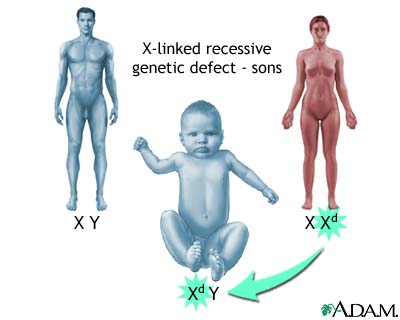Alternate Names : Pseudohypertrophic muscular dystrophy, Muscular dystrophy – Duchenne type
Definition
Duchenne muscular dystrophy is an inherited disorder that involves rapidly worsening muscle weakness.
Overview, Causes, & Risk Factors
Duchenne muscular dystrophy is a rapidly-worsening form of muscular dystrophy. Other muscular dystrophies (including Becker’s muscular dystrophy) get worse much more slowly.
Duchenne muscular dystrophy is caused by a defective gene for dystrophin (a protein in the muscles). However, it often occurs in people without a known family history of the condition.
Because of the way the disease is inherited, males are more likely to develop symptoms than are women. The sons of females who are carriers of the disease (women with a defective gene but no symptoms themselves) each have a 50% chance of having the disease. The daughters each have a 50% chance of being carriers.
Duchenne muscular dystrophy occurs in approximately 1 out of every 3,600 male infants. Because this is an inherited disorder, risks include a family history of Duchenne muscular dystrophy.
Pictures & Images
X-linked recessive genetic defects – how boys are affected
 There are several X-linked (or sex-linked) recessive genetic disorders, (hemophilia, muscular dystrophy) which are inherited through a genetic defect on an X chromosome. A female has 2 X chromosomes, one she inherited from her mother and one she got from her father. A male has an X chromosome from his mother and a Y chromosome from his father. Since male offspring receive their X chromosome from their mothers, the inheritance of a defect attached to that one copy of the X will cause the disorder.
There are several X-linked (or sex-linked) recessive genetic disorders, (hemophilia, muscular dystrophy) which are inherited through a genetic defect on an X chromosome. A female has 2 X chromosomes, one she inherited from her mother and one she got from her father. A male has an X chromosome from his mother and a Y chromosome from his father. Since male offspring receive their X chromosome from their mothers, the inheritance of a defect attached to that one copy of the X will cause the disorder.
X-linked recessive genetic defects – how girls are affected

There are several X-linked (or sex-linked) recessive genetic disorders, (hemophilia, muscular dystrophy) which are inherited through a genetic defect on an X chromosome. A female has 2 X chromosomes, one she inherited from her mother and one she got from her father. A male has an X chromosome from his mother and a Y chromosome from his father. Females may get the defective gene either from her mother’s defective X, or, if her father has the disorder, from her father. In either case, the girl will be a carrier and will probably pass the defect to her offspring. She will not manifest the disorder the way a boy would, because she has 2 X chromosomes, and the dominant X will compensate for the defect on the recessive X. Only if a female has 2 parents with the defect on their X chromosomes will she get a milder form of the disorder.
X-linked recessive genetic defects

There are several X-linked (or sex-linked) recessive genetic disorders, (hemophilia, muscular dystrophy) which are inherited through a genetic defect on an X chromosome. A female has 2 X chromosomes, one she inherited from her mother and one she got from her father. A male has an X chromosome from his mother and a Y chromosome from his father. If a woman has the defect on one of her X chromosomes, and the father’s X chromosome is normal, there is a 25% chance for each pregnancy to produce: an unaffected girl; a girl who carries the defect; an unaffected boy; or a boy with the disorder.
-
Duchenne muscular dystrophy : Overview, Causes, & Risk Factors
-
Duchenne muscular dystrophy : Symptoms & Signs, Diagnosis & Tests
-
Duchenne muscular dystrophy : Treatment



Review Date : 3/9/2010
Reviewed By : Neil K. Kaneshiro, MD, MHA, Clinical Assistant Professor of Pediatrics, University of Washington School of Medicine; Daniel B. Hoch, PhD, MD, Assistant Professor of Neurology, Harvard Medical School, Department of Neurology, Massachusetts General Hospital. Also reviewed by David Zieve, MD, MHA, Medical Director, A.D.A.M., Inc.
The information provided herein should not be used during any medical emergency or for the diagnosis or treatment of any medical condition. A licensed medical professional should be consulted for diagnosis and treatment of any and all medical conditions. Call 911 for all medical emergencies. Links to other sites are provided for information only — they do not constitute endorsements of those other sites. © 1997- 2010 A.D.A.M., Inc. Any duplication or distribution of the information contained herein is strictly prohibited.
